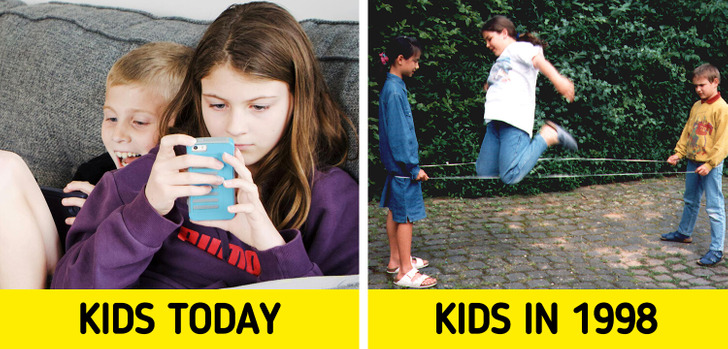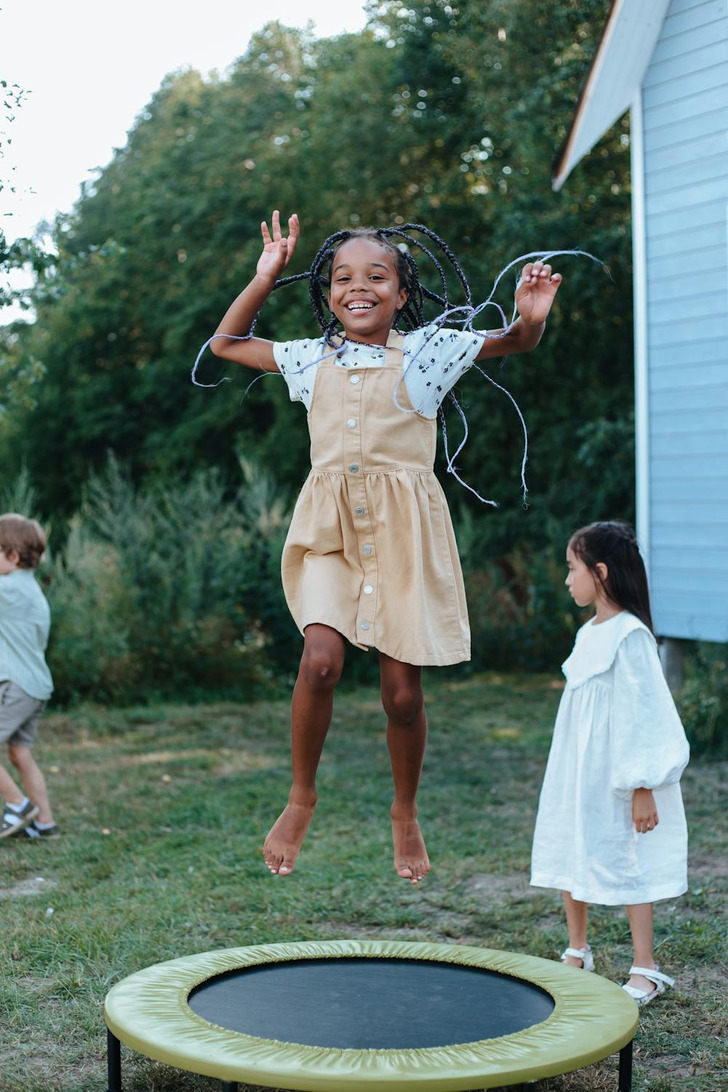How Nostalgic Activities Can Help Kids Thrive Beyond Screens / Bright Side
Screens are everywhere in our daily lives, from self-checkout stations to tablets for reading. They’re a big part of today’s world, but cutting back on screen time can help improve health. For kids, less screen time means better physical health, less risk of obesity, and more opportunities to play and explore.
How can I reduce my child’s screen time?

It’s especially important for kids who spend a lot of time learning on computers. Breaks for physical activity and plans to disconnect after school can make a big difference. The American Academy of Pediatrics suggests no screen time for kids under 2, just one hour a day for kids 2 to 12, and only two hours daily for teens and adults. Cutting back also helps parents monitor what their kids see online and on social media.
Too much screen time isn’t just a kid problem—it affects adults too, leading to risks like poor sleep, obesity, and even strained relationships. For teens, studies have linked excessive screen use to anxiety, depression, and shorter attention spans. But reducing screen time doesn’t have to be hard! Start small with these tips: set time limits, make meal areas phone-free, and spend time talking face-to-face.
What are nostalgic games for kids?

- 1. Sardines
Turn hide-and-seek into a group adventure! One player hides while everyone else counts. When someone finds the hider, they join them in the hiding spot. Keep playing until everyone is packed into the hiding spot like sardines. - 2. Marbles
This ancient game is simple and fun! Draw a circle and fill it with marbles. Players take turns using a “taw” (shooter marble) to knock others out of the ring. Keep the marbles you knock out, and the player with the most marbles at the end wins. - 3. Mother May I?
In this game, one player is “Mother” and stands at one end of the play area, while the others line up at the opposite end. Players take turns asking, “Mother, may I…?” and suggest actions like giant steps or bunny hops. The mother approves or changes the request. The first to reach Mother wins and becomes the next Mother! - 4. Elastics
Grab a long piece of elastic and have two players stretch it around their ankles. A third player jumps in and out of the elastic in patterns. As they master the jumps, the elastic is raised from ankles to knees to hips. Chanting rhymes while jumping adds extra fun!
- 5. Spud
One player is “It” and throws a ball while calling out a number. The player with that number grabs the ball and yells “Spud!” Everyone freezes while they try to tag another player with the ball. Tagged players or missed throws earn letters until someone spells “Spud” and is out. - 6. Ghosts in the Graveyard
Combine hide-and-seek and tag with a spooky twist! One player is the ghost and hides while everyone counts. When the ghost is found, they chase the others as they race to home base. Tagged players become the ghosts in the next round. - 7. Retro Dance Party
Throw a dance party with classic moves! Learn dances like the Twist, Macarena, or moonwalking with online tutorials, then groove to the music. It’s a fun way to exercise and share laughs while revisiting iconic dances. - 8. Monkey in the Middle
In this game, one player (the monkey) tries to catch a ball being tossed between others. If they catch it, the thrower becomes the new monkey. For extra fun, mix it up with beanbags or stuffed animals instead of a ball! - 9. Hacky Sack
Keep a small sack in the air using your body—but no hands allowed! Use your feet, knees, or head to keep it up. Hacky sack is great for solo practice or group fun and helps build coordination and reflexes.
Why is outdoor play important for children?
As Claire McCarthy, MD, a primary care pediatrician at Boston Children’s Hospital and an assistant professor of pediatrics at Harvard Medical School, explains, today’s children are spending much more time indoors than previous generations. This shift is driven by increased screen time, busy schedules, safety concerns, and limited outdoor spaces—a trend that affects adults as well. However, outdoor play is essential for children’s growth in several ways. Sunshine helps the body produce vitamin D, which supports the immune system, improves sleep, and boosts mood. Plus, spending time outdoors encourages exercise, ensuring that kids get the movement they need for healthy development.
Beyond physical benefits, outdoor play nurtures important life skills like executive function, creativity, and the ability to take risks. These skills help kids develop confidence, problem-solving abilities, and social skills like cooperation and empathy. Additionally, time spent in nature fosters an appreciation for the environment, teaching kids to value and protect the planet. So, take a step outside with your children, encourage them to explore, and advocate for safe, accessible spaces where all kids can play.
How do I encourage my kids to play outside?
- Start Small
Introduce your kids to the outdoors gradually by starting in the backyard. This familiar space offers a comfortable environment with fewer distractions, making it easier for them to adjust. Keep a close eye on them to ensure safety but give them space to explore. You can even bring toys like road signs to spark curiosity and help them feel more at ease in the outdoor world. - Make it Fun
Engage your child’s imagination by creating fun, make-believe games that can only happen outdoors. Whether it’s pretending to hunt for treasure with a map or crossing a jungle river, these imaginative scenarios will keep them excited about outdoor play. The more creative the game, the more they’ll want to explore. - Outdoor Toys
Bringing their favorite indoor toys outside can make the transition easier for kids. Whether it’s building blocks, costumes, or a small playhouse, these familiar items will help them feel more comfortable and excited about playing outdoors. Just make sure to leave screens inside to keep the focus on active play.
- Involve Them
Get your kids involved in everyday outdoor activities like watering plants, washing the car, or gardening. These tasks make outdoor chores feel important and fun. Give them their mini tools, like a wheelbarrow or small rake, to encourage their participation and develop a sense of responsibility. - Family Time
Turn outdoor activities into family bonding moments. Plan regular family hikes, bike rides, or park trips where everyone can enjoy nature together. These activities not only create positive memories but also teach your kids the value of spending quality time outdoors. A family calendar of outdoor adventures is a great way to stay motivated and explore new places. - Water Play
When the weather is warm, water activities are a great way to encourage kids to spend more time outside. Sprinklers, water guns, and small pools are all fantastic ways to keep them cool and entertained. Water play not only beats the heat but also adds a fun element to their outdoor adventures. - Outdoor Chores
Incorporate outdoor chores into playtime. Whether it’s feeding the pets, hanging clothes, or cleaning the patio, these tasks give kids a sense of purpose and connection to the outdoors. They’ll feel proud to help out while also getting fresh air and staying active.
What’s the best way to balance screen time and outdoor play?
Balancing screen time and outdoor play is crucial for kids’ physical and emotional development. Screen overuse has led to issues like poor core strength and sensory deficiencies, which are often visible in classrooms designed to help children adapt to the effects of too much screen time. Nature, on the other hand, helps children develop their motor skills, improve their balance, and stimulate their imagination. Simply put, outdoor play is essential for healthy growth, something screens can’t provide.
One effective way to ensure kids get enough outdoor play is to establish routines that prioritize nature. Spending more time outside in natural settings allows children to use all their senses, which aids in brain development. These outdoor experiences also help reduce anxiety and stress, which are often exacerbated by too much screen exposure. Nature offers children the space to relax, explore, and connect with their surroundings, which screens simply cannot replicate.
To create balance, parents can start by setting limits on screen time, such as designating certain hours for outdoor play and others for screen activities. It’s helpful to encourage creativity and active play in nature, allowing children to explore freely and engage with the world around them. Over time, reducing screen dependency and increasing time spent outdoors can foster healthier, happier children.
What is Screen Dependency Disorder?
Screen Dependency Disorder (SDD) is a condition that arises from excessive and unregulated screen use, particularly among children. This disorder can manifest in addictive behaviors related to activities such as video gaming, social media, and internet browsing. Unlike adults, whose brains are more developed, children’s brains are highly susceptible to changes that can negatively impact their neural development, leading to the development of this disorder.
There are several other terms associated with screen dependency, including:
- Internet addiction
- Internet gaming disorder
- Compulsive internet use
- Video game addiction
- Mobile phone dependence
- Social media addiction
Psychologist Dr. Aric Sigman notes in his research that the term “addiction” is increasingly used to describe children engaging in screen-related activities in a problematic and dependent way.
Studies have shown that screen dependency is becoming more widespread. A 2015 study revealed that 12% of young American gamers were considered “pathological video gamers.” These kids exhibited addiction-like behaviors despite there being no chemical substances involved. Psychotherapist Dr. George Lynn observes that 80% of his patients’ issues are linked to excessive screen time, often resulting in personality problems, particularly due to poor sleep from late-night gaming or social media use.




